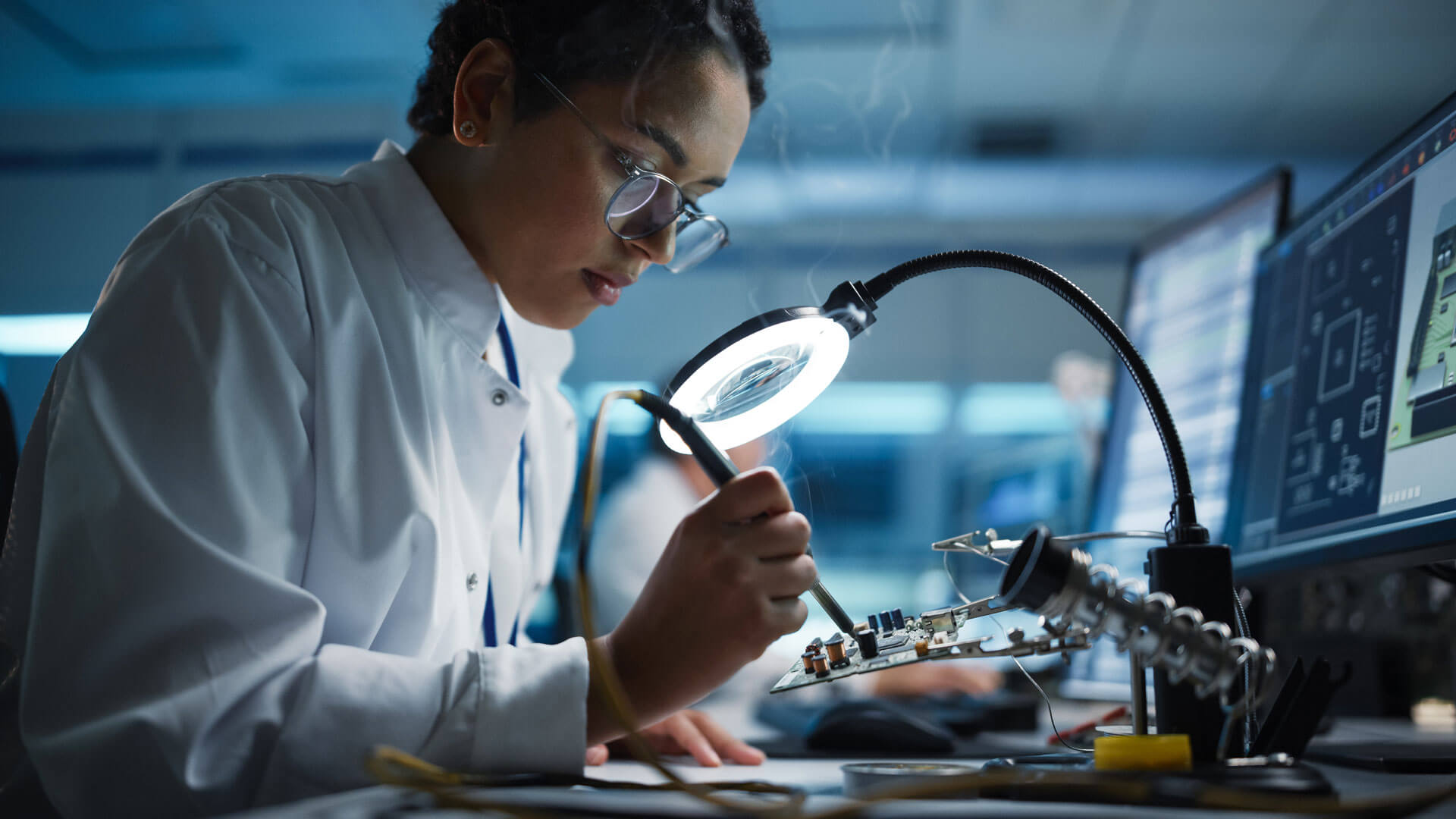Robotic Simulation Series, Part I: The Basics and the Phases of Robotic Simulation in Manufacturing
Q: Let’s begin with the basics. What is a Robot?
A: In industrial terminology, a robot is defined as a machine that consists of a manipulator and a control unit. The manipulator can be programmed via the control unit, to move through a programmed path to perform various tasks. The manipulator typically has End-Of-Arm-Tooling (EOAT) mounted at the end, which is the equipment that performs a task. The manipulator merely positions the EOAT to the desired location. An industrial robot typically comes with six axis/joints; however, they can have more or less than six axis depending on their intended application.

Q: Why do we need a robot instead of a human to perform a task?
A: There are a lot of reasons for choosing a robot over a human. Some of them are:
- When the working environment is hazardous for a human.
- When the product is too big or too heavy for humans to handle.
- When the task must be performed with high precision, high repeatability and high speed over extended periods of time.
- To reduce operational costs in the long run.
- To avoid or reduce disruptions in production, which are often human in nature (disputes, strike, health related reasons, etc.).
Q: What is robotic simulation?
A: Robotic simulation can be described as a process of creating, using simulation software, an exact replica of a robotic workcell and its process in a virtual environment. The purpose is to identify and eliminate any issues or inefficiency in the process, even before the various components of the robotic workcell are ordered and manufactured in the real world.
Q: What are the benefits of virtually validating the robotic process?
A: The benefits of validating the robotic process include: eliminating or reducing unnecessary rework and its associated costs; avoiding delays in manufacturing and procurement of the various components; enabling simultaneous engineering and buyoff on design, simulation and controls; reducing the time required to integrate the various systems (electrical, mechanical, controls, etc.); and achieving faster production lead-times.
Q: Which robotic simulation software programs are currently available in the market?
A: Robotic simulation software programs can be categorized into two groups: generic and robot specific. Generic simulation software programs can be used to simulate and validate processes using different robot models from various robot manufacturers. However, generic software will typically require additional licenses to develop the paths and parameters that are specific to a robot manufacturer.
Some commonly used generic simulation software programs are:
- Process Simulate developed by SIEMENS
- Delmia V5 / 3D experience developed by Dassault Systèmes
- CimStation developed by AC&E
- RoboDK
Process Simulate by SIEMENS is by far the industry leader in the robotic simulation space, with a large user base across various OEMs and their suppliers.
Robot specific simulation software programs are developed by the robot manufacturers themselves, to simulate and develop paths and programs for their respective robot models. However, robot specific software cannot be used to simulate robots from other manufacturers and, as a result, are not as widely used as generic simulation software.
Some of the commonly used robot specific software programs are:
- Roboguide by FANUC
- Robot Studio by ABB
- Moto SIM by Motoman
- KUKA SIM by KUKA
Q: Who are the typical users of robotic simulation software?
A: Robotic simulation software is typically used by OEMs, line builders, engineering services companies, training Institutes and academia.
Q: What are the different phases of a robotic simulation investigation?
A: Robotic simulation investigations consists of the following phases:
Process Planning (PV) Phase
In this phase, a high-level study is carried out to identify the robot type, robot quantity, part orientations, part placements, joining process allocation, equipment identification equipment quantity and overall space required.
Design Phase
A more detailed robotic simulation investigation is carried out on the PV workcell, by using the tools and equipment that are specifically designed to process the part being produced.
Investigations are carried out for the following reasons:
- Confirm or modify the joining allocation from PV Phase.
- Ensure the robot is able to reach all the programmed locations without any issues.
- Confirm the robot type and quantities identified during the PV Phase.
- Validate the tools and equipment being designed, to ensure they are free of collision.
- Tools are also checked to ensure minimum clearances are maintained.
- Create detailed working models (with kinematics) of the tools and equipment.
- Finalize the installation location of robots, tools, equipment, fence etc.
Detailed simulation and documentation phase
The robot paths are further optimized and the robotic workcell is further developed to create a “Digital-Twin” of the real world. Some of the simulation activities carried out in this phase are:
- Sequence the robot paths to avoid Robot-to-Robot collision.
- Optimize the robot paths to achieve the desired cycle time.
- Define Safe & Restricted zones for the robot.
- Create Service & Maintenance paths.
- Create a detailed Sequence of Operation (SOP) of the entire robotic workcell.
- Create documentation related to robot setup for the installation and commissioning teams.
Offline programming and field support
In this phase, robot paths prepared in a simulation environment are defined with specific parameters and downloaded to a real robot. Robot paths downloaded to the real robot are then adjusted in the real world to compensate for any installation errors. The adjusted robot paths are then fed back to the simulation environment to update the virtual robotic workcell with the latest data and positions.
Q: How accurate and dependable are the output of the simulation studies?
A: Some of the typical output of simulation studies such as process validation, tool validation, cycle time confirmation, signaling and zoning, and offline robot programs are extremely accurate when used in conjunction with realistic robot simulation (RRS) and robot controller software (RCS) modules.
The accuracy of the simulation studies is also dependent on the positional accuracy of tools and equipment in the real world.
Q: Can an existing factory be recreated in the virtual environment?
A: Yes. An existing factory can be 3D scanned by using the hardware and software developed by vendors like FARO.
The scanned factory data can then be imported into SIEMENS process simulate and used as a template for positioning the 3D tools and equipment in the virtual environment.
Q: Where does robotic simulation figure into the framework of Industry 4.0?
A: Simulation is one of the basic pillars of the industry 4.0 framework.
The latest simulation softwares available today have enormous capabilities and offerings that make it Industry 4.0 compliant. Some of them are:
Cloud Based Services: Developers are providing cloud based licensing of the simulation software, to enable better collaboration between various stakeholders, at the same time being extremely cost effective for the organization.
Industrial Internet of Things (IIoT): Using PLC Emulator the user can integrate real world PLCs, Robots and devices, with their “Digital Twin” in simulation, thereby allowing Real-Time monitoring of signals from various sensors which are then used to make intelligent decisions.
Augmented Reality (AR): Simulation softwares of today have the capability to integrate with Augmented Reality devices and headsets, thereby enabling the user to visualize and interact with objects in the digital world, thus providing a more immersive experience for the user while examining the product and process.

What are the upcoming trends in the field of robotic simulation?
A: When we talk of upcoming trends in robotic simulation, the concept of virtual commissioning is quickly becoming the new norm in the industry across OEM’s. We will cover the concept of virtual commissioning and its value proposition in part two of this series.



